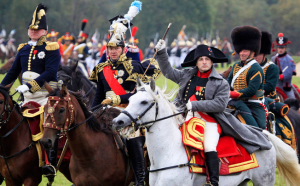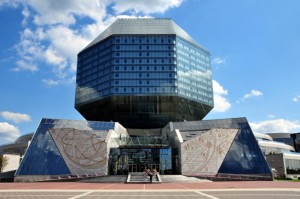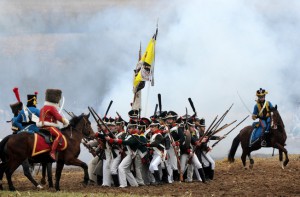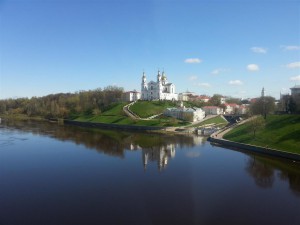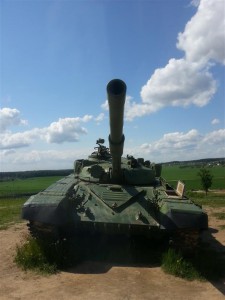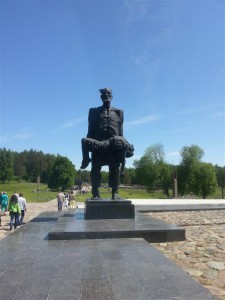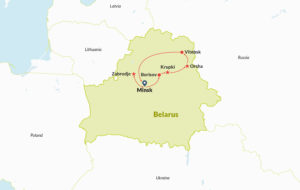In Napoleon’s Footsteps
Highlights of this seven-day trip following Napoleon in Belarus:
– in the footsteps of Napoleon; to Borisov, Studenka, Berezina, Zembin, Krupki and Vitebsk
– museums and monuments reminiscent of WW2; Khatyn, Stalin Line and the great museum of WW2
– the village museum in the village of Zabrodje with unique and retro collections from WW1, among others
In one week you will pass battefields from Napoleon’s adventures against Russia, including the site of the famous battle at the Berezina river. But you will not just follow Napoleon in Belarus. Also WW1 and WW2 are present in the program! Because Belarus played and important and unfortunate role in all three major wars from the 19th and 20th century.
A visa is no longer required for stays up to 30 days with arrival and departure at Minsk Airport since July 2018, for most countries.
Read more about the highlights of travelling in Belarus, plus practical advise, here.
Day 1
Arrival in Minsk and a city tour. Before you will follow Napoleon in Belarus, first get to know the capital city!
Sightseeing tour of Minsk includes the main attractions of the city. These include main avenues and architectural monuments of the XVIIth – XXth centuries. Like the Upper Town with the City Hall, the St. Spirit Cathedral, ancient churches and monasteries, and the small streets of the Trinity Suburb.
Onwards to “The Isle of Tears”, the Victory Monument and the National Library of Belarus (included into the list of the most outstanding buildings of the world).
Transfer to hotel and check-in.
Day 2
You start with a drive to to Borisov, a crucial location in times when the French Emperor Napoleon with his Grand Army was retreating from Moscow in 1812, being pursued by the Russian Army. Cannon from the Napoleonic era is still kept by the Borisov state museum (entrance).
Followed by a transfer to Studenka village and Brili field, visiting the site of the famous Berezina River crossing, in which the Napoleon’s army lost thousands of its soldiers. This historical event was later widely depicted on numerous paintings by various artists. Today there are several memorials nearby, commemorating the victims of the war. And local clubs of military history are traditionally reenacting the event during special festivals.
Then, onwards to Zembin, where Napoleon spent his first night after the tragedy on Berezina. There is a legend that at local church repented of his sins in the presence of a priest the Grand Army’s Marshal.
Finally for today, a transfer to the farmstead named “Bivouac 1812”, which continues telling a story about the Napoleonic War. Its interior is full of small details that bring us back to the beginning of the XIXth century. The farmstead houses its own museum, devoted to the events of the war, which has a collection of artifacts, portraits and even army officers’ uniforms. Guests are also invited to have some training in horse-riding just on site!
Overnight at the farmstead.
Day 3
Staring with a transfer to the town of Krupki. There is a theory that Napoleon’s coach, carrying his numerous treasures, went down in the lake just behind this small town.
Next on the program are visits to Bobr and Orsha. In Orsha the French Emperor stayed twice: on the way to Moscow and during his sad way back. He spent the nights at Jesuit collegium; from there he gave instructions to his marshals. In Orsha Napoleon ordered to burn down lots of coaches, including ones with seized goods from Moscow Kremlin – to ensure the Army had enough mobility.
Transfer to the city of Vitebsk, known for the Battle of Vitebsk in July 1812, which ended up with the Russian forces making a strategic retreat from the battlefield. In Vitebsk Napoleon stayed at the Governor’s Palace and was planning to spend the whole winter there in order to give the rest to the Army and to replenish the Army’s stock (for example, he ordered to build 36 bakeries in Vitebsk for producing bread for the soldiers). In reality, the French Emperor decided to leave Vitebsk in 2 weeks and to move towards Smolensk.
Overnight in Vitebsk. This is the last site connected to the theme Napoleon in Belarus.
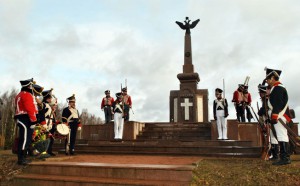
Day 4
Today Vitebsk is known as the cultural capital of the country because of the city’s rich artistic heritage. Marc Chagall, an outstanding artist of the XXth century, was born here – moreover, Vitebsk became his main source of inspiration for the entire life, the town’s views could be recognizable on lots of Chagall’s paintings.
Such world-famous artists as Vasiliy Kandinskiy, Ilya Repin, Kasimir Malevich also once lived and created in Vitebsk.
During the city tour you will visit Marc Chagall Home-Museum (entrance) and Marc Chagall Art-Centre (entrance), as well other sights, which give Vitebsk an elegant sense of past: the City Hall, Holy Assumption Cathedral, Holy Resurrection Church, the Governor’s Palace, the famous Kirov Bridge across the Western Dvina River.
Transfer to Khatyn, deeply-affecting memorial that commemorates all innocent victims of the World War II. The village of Khatyn was burned down and the entire population was massacred by the Nazis in 1943. Today it is a symbol of the tragedy of the Belarusian nation.
Transfer to Minsk. Overnight in Minsk.
Day 5
Excursion at World War II museum (entrance). It was the first museum in the world to reveal the story of this disastrous war, as it was opened already in 1944, during the Nazi occupation. Among the museum’s first exhibits were the partisan movement chronicles, handwritten and printed books, handmade weapons. Today the museum, which occupies an area of 3,000 sq.m., houses more then 8,000 exhibits, including combat reports, diaries, drawings, flags of military units, military uniforms, military weapons, vehicles and other items.
Transfer to Stalin Line (entrance) – an open-air museum of military fortifications, including the defensive line with trenches, anti-tank obstacles and ditches, anti-personnel obstacles and machine-gun pillboxes. Visitors can walk around a pillbox and sit in a gun emplacement, stroll along the trench system and clamber over a tank. The guides are dressed in uniforms of the day. To feel the atmosphere of that by-passed war you should also try the sample rations eaten by soldiers of the time.
Back to Minsk and accommodation.
Day 6
Transfer to Zabrodje (115 km from Minsk).
Village Museum fermented – it is a unique place where the exhibits of antiquity, reviving the memory of the events of the past and preserved evidence of the First World War under the open sky.
The most beautiful and a great exhibit in this unique museum, of course, it is the restored chapel of Boris and Gleb. In front of the chapel is located is small but extraordinary exhibition dedicated to the events of the First World War. Here is a collection of original objects and documents reflecting military routine. Old photographs document the long-gone days, and relate to events that took place around the ferment.
Another highlight of the museum is an extensive collection of retrotehniki entitled «Molotov Drive», which collected and restored Daniel Tsitovich. It presents the Russian cars from the years 1936-1960. Including limousines and also the Volga M21 model. Many have participated in the filming of movies.
Return to Minsk and overnight.
Day 7
Check-out and transfer to the airport. End of your trip, following Napoleon in Belarus.
At two people the price of this program, following Napoleon in Belarus, is €1,545 per person, at four people it is €1,120 per person. For other group sizes please send us a mail.
Included in the offer are:
– Letter of Invitation (LOI) for the visa
– a total of six nights of accommodations in 3* hotels in Minsk (5x), Vitebsk (1x) and in a Farmstead in Bivak (1x), on the basis of breakfast included and stay in TWIN rooms.
– transfers during the whole tour in a car with driver & guide-interpreter (resp. a minivan when 3-6 people)
– services of an English speaking guide during the whole program, days 1-6
– entry tickets for all museums and sites as mentioned in the program
– transfers airport-hotel-airport in Minsk
Single Supplement is €165.
Not included in the offer are the international flight tickets, the visa, lunches & dinners and services not mentioned. Finally we charge €15 per booking as a contribution to the GGTO Guarantee Fund.
Contact
-
Telephone
tel. (00)31 23 700 12 22
(00)31 6 47 12 64 09
-
Email
